Rennie Scaysbrook | August 31, 2018
The Art of the Balance
The first year of the Junior Cup has been anything but smooth sailing for MotoAmerica with constant balancing of machines that are fundamentally different in design. We spoke to all the major players at Sonoma to see if there’s light at the end of the tunnel
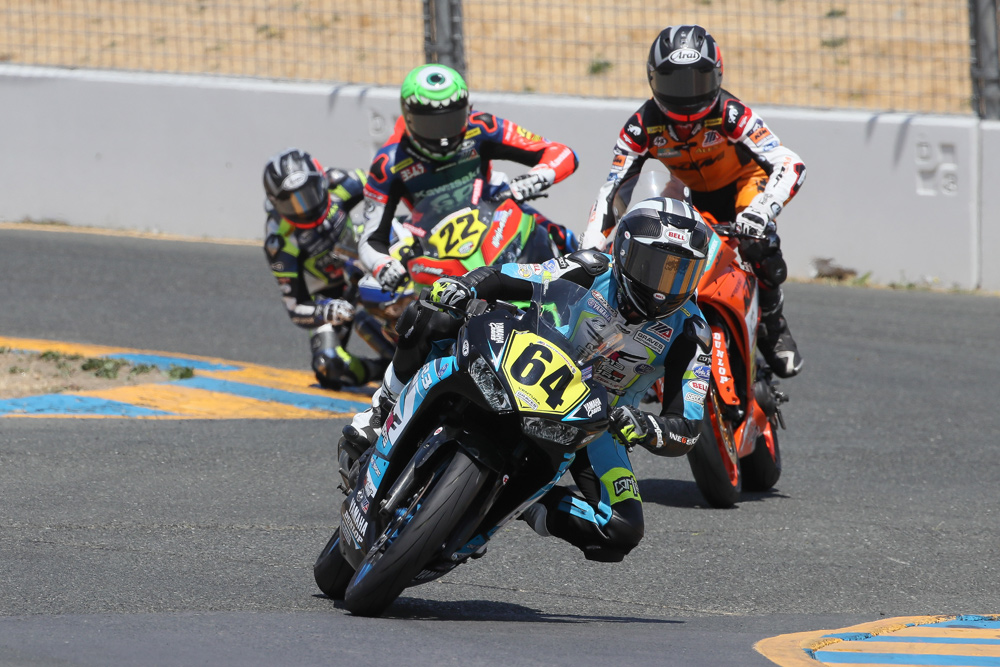 Race two at Sonoma was the first time a Yamaha won, marking the first time every competing manufacturer had taken a race win. It had been a long road up to this point.
Race two at Sonoma was the first time a Yamaha won, marking the first time every competing manufacturer had taken a race win. It had been a long road up to this point.
Motorcycle racing is never an even sport. Most of the time it’s one rider or team who has an advantage, but when you throw in machines that are as different as the personalities riding them, it very rarely makes for a happy paddock.
Replacing the one-make KTM RC Cup with the FIM-spec Supersport 300 class has been anything but a smooth transition for MotoAmerica. Gone is the field of single-cylinder 375cc machines, and in its place, comes a field comprised of Yamaha’s 321cc twin-cylinder YZF-R3, Kawasaki’s 399cc twin-cylinder Ninja 400 and KTM’s RC 390 R—the latter a special machine developed by KTM factory riders with the sole purpose of winning the World Supersport 300 Championship and any national series for which it is eligible (Italy, Great Britain, Spain, Australia).
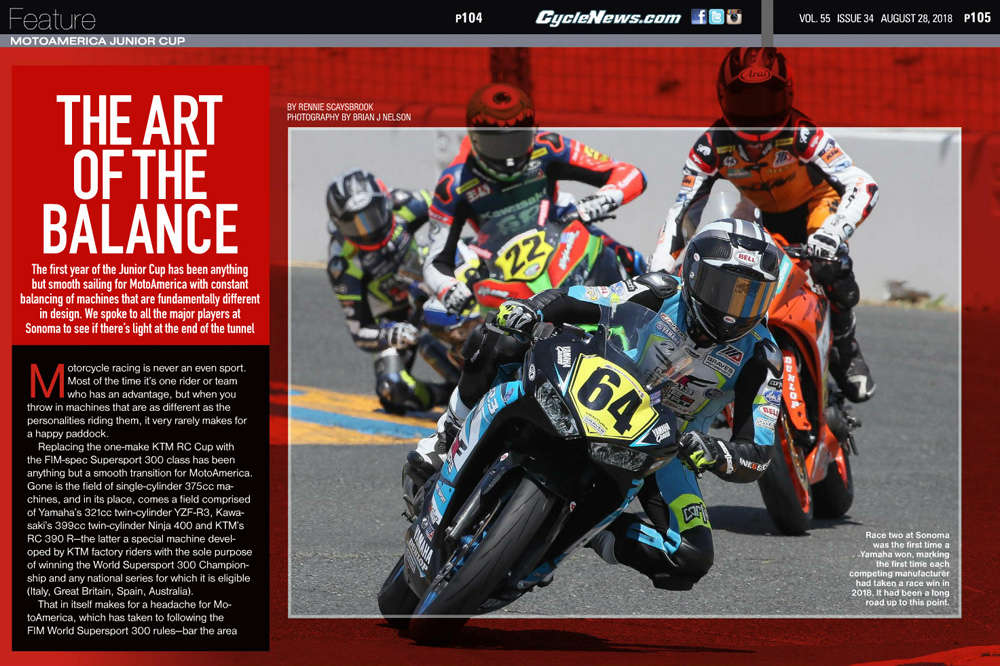
Photography by Brian J Nelson
That in itself makes for a headache for MotoAmerica, which has taken to following the FIM World Supersport 300 rules—bar the area of motorcycle weight versus combined rider/motorcycle weight and a 450-rpm-lower limit for the KTM—as guidance for the balancing issue of the machines.
Until race two at this last round at Sonoma, no Yamaha had taken a win in the series, with Kawasaki’s Ashton Yates and KTM’s Alex Dumas taking all but one win in the nine races contested—the other went to Brazil’s Renzo Ferreria on a Kawasaki at race two in Utah.
For MotoAmerica, the 2018 Junior Cup has been a baptism by fire in the public domain, one even CEO Wayne Rainey admits has been far from easy.
“We wanted to build a base and make it inexpensive and get the other brands in. It did not roll out that way,” says Rainey. “We want it to be a low-cost, step-in class that kids can come and race and families can be a part of the championship. We can see the talent and where it goes from there. Then they can go through our structure from that point. I think it was rolled out poor[ly]. That discouraged a lot of people I think, including us. But we’ve just kept working on it daily.
“What we always told all the manufactures was we were going to balance the class. Not to the lowest denominator, but we just didn’t want somebody to have a big advantage. We were trying to make it to where they could all be competitive, and we wanted the riders to make the difference, not how they set the bike up. That’s what we were shooting for. It sounds easy on paper, but it was very difficult.”
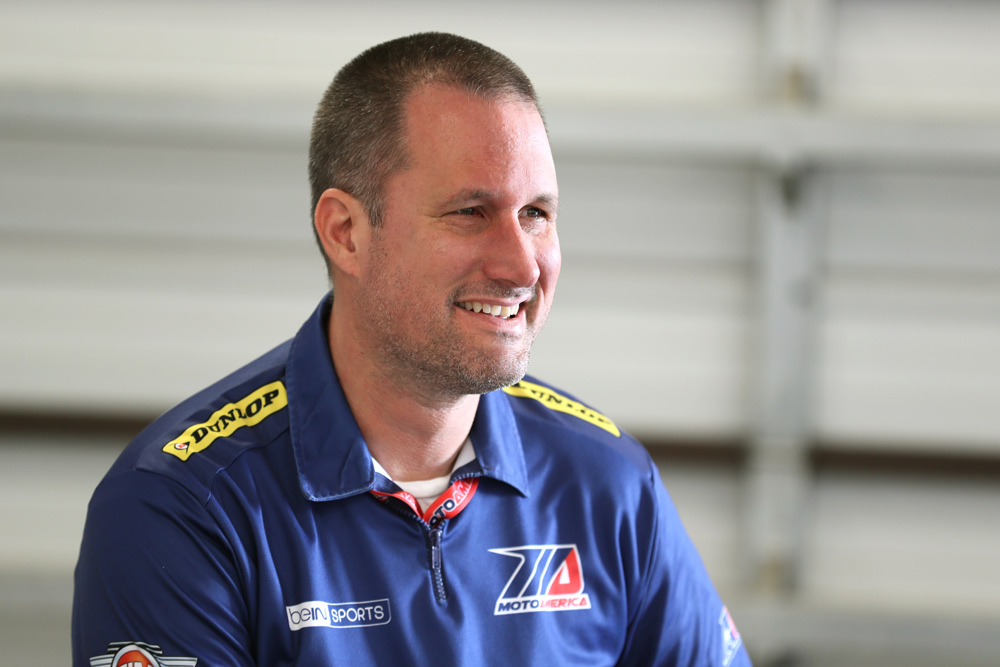 James Morse is the man in charge of ensuring there is parity between the competing Yamahas, Kawasakis and KTMs.
James Morse is the man in charge of ensuring there is parity between the competing Yamahas, Kawasakis and KTMs.
MotoAmerica Technical Director James Morse has been the man charged with implementing the various balancing changes throughout the year, going back and forth with FIM SBK Technical Director and architect of the current Supersport 300 rules, Scott Smart. He admits the process of balancing has been fraught with difficulties, creating a situation where it’s impossible to keep everyone happy. In short, the balancing is achieved via changing the motorcycle’s rev limit via the supplied, password-locked HM Quickshifter and the motorcycle’s weight, and in the case of the Yamaha, allowing for airbox modifications, but there’s more to it than that.
“Our rules are different now to what they run in Europe,” starts Morse. “Last year in Europe, Kawasaki had the 300, Yamaha had their R3 and KTM had their 390. You also had Honda with their CBR500R. It was very successful. So, we were like, ‘that’s a good plan. Let’s do that.’ We followed their rules, although we made a small exception in allowing our ECUs to be flashed here within certain parameters for stuff like removing the fuel cut and speed limiters.
“Then right before the season, Kawasaki came out with their Ninja 400 which qualified as a bike that could be used. And KTM came out with their R-version 390. We were kind of in the dark of how capable the bikes were.”
The opening two rounds of the series saw plenty of angry faces as Morse and MotoAmerica admittedly went too heavy on the machine everyone knew was going to be a contender—the Kawasaki Ninja 400. As the bike with the largest capacity and a rider of Ashton Yates’ talent on board (Yates took second in race one of round one at Road Atlanta and cruised to victory in race two), the Ninja 400 came in for restrictions. For round three (round two for the Junior Cup) at VIR, the 400 lost 2150 rpm and Yates could do no better than a DNF in race one and ninth in race two as the top Kawasaki rider.
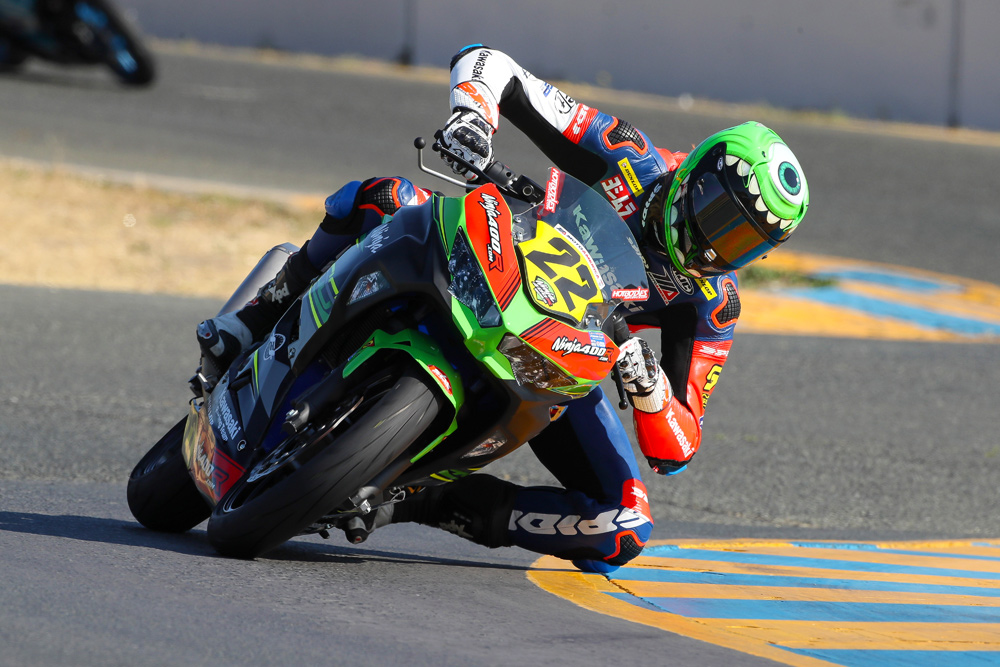 Ashton Yates is one of the bigger guys not just on the Junior Cup grid, but the entire MotoAmerica paddock and the lack of a combined weight would affect him more than most.
Ashton Yates is one of the bigger guys not just on the Junior Cup grid, but the entire MotoAmerica paddock and the lack of a combined weight would affect him more than most.
Meanwhile, KTM rider Alex Dumas—despite seeing 1000 rpm knocked off his maximum redline—won both races at a canter, with Yamaha riders filling out the podium in both races.
“We had some situations with overcompensating at VIR where we took too much out of the Kawasaki, where they really couldn’t find the correct gearing for the bike,” Morse said. “We’ve kind of gone both ways on it since then. At this point, we feel like we have a pretty good balance.”
The MotoAmerica rules differ from the FIM World Supersport 300 rules by one important factor, that being using just a machine weight (see table) as opposed to a combined rider and bike weight as used in Europe, which is something Morse feels is unique to the field racing in America.
“Looking at our field, a combined rider/weight format wouldn’t be correct,” says Morse. “You have riders like Ashton Yates that would ultimately be able to remove a lot more weight from his bike, simply because his body weighs more. He’s already leading most races. Some of our heavier riders are going faster already, so giving them more weight off the bike, wouldn’t necessarily affect their balancing.”
Does this unfairly target larger riders like Ashton, or help lighter riders such as Jamie Astudilo?
“Ashton and Dumas are definitely riding at a very high level,” says Morse. “Ashton Yates did very well in the KTM RC Cup also, and all those bikes were equal. So, it’s hard to say. I don’t think he’s at a disadvantage by any means right now. I think it is a lot easier for the bikes to just say that the bike must be X weight. It’s easier to control.”
KTM is in a different boat. The Austrian manufacturer committed a large amount of time and resources into building a specific homologated motorcycle for the FIM World Supersport 300 Championship, and young French Canadian Alex Dumas has been putting it to good use by leading the championship by 27 points after the Sonoma round, despite crashing in race one.
At Laguna Seca’s round five (four for the Junior Cup), KTM was hit with the largest weight increase yet seen in the series of six kilograms (13.2 pounds), bumping them up to 142kg (313.1 pounds), although it didn’t seem to matter as Dumas and fellow KTM Orange Brigade rider Sean Ungvarsky went one-two after several Yamaha riders crashed out.
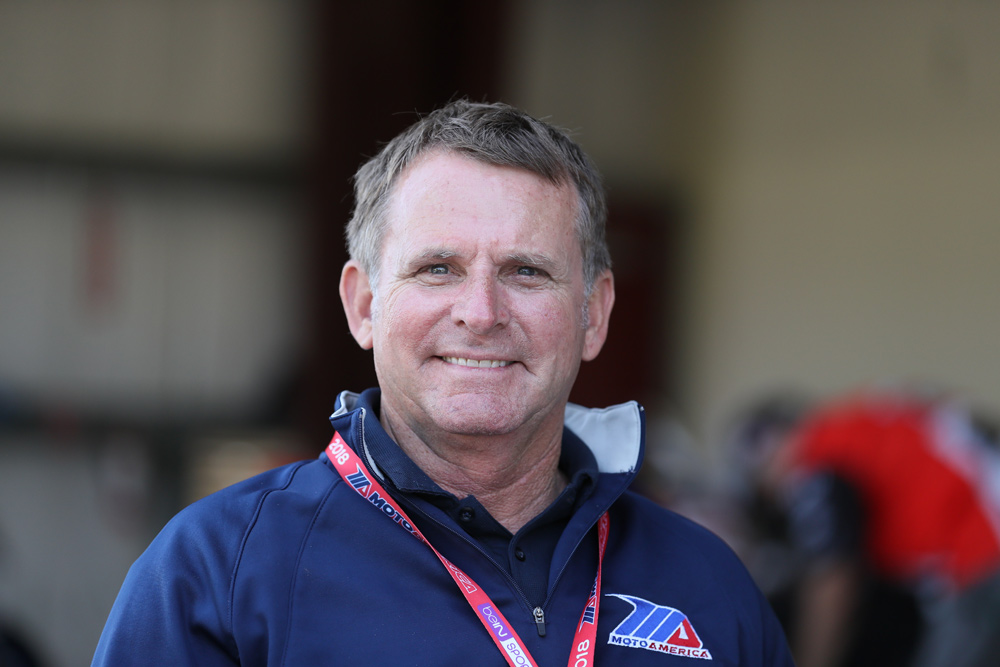 For MotoAmerica CEO Wayne Rainey, the transition from the RC Cup to the Junior Cup has been far from smooth, but there’s light at the end of the tunnel.
For MotoAmerica CEO Wayne Rainey, the transition from the RC Cup to the Junior Cup has been far from smooth, but there’s light at the end of the tunnel.
“I think the only situation KTM would be happy with is to unrestrict all the bikes,” says Morse. “They’ve obviously put in a lot of work into that bike, and we understand the effort that they’ve put into it. However, going into this thing, we told everyone that the bikes would be balanced. It’s because we’re trying to make the riders [shine]—this class isn’t necessarily about the bikes. So, I understand, but I don’t know if there’s much we can do about it. There’s other classes that are completely unrestricted.”
Regarding KTM’s development of a race machine costing the best part of $20,000, Morse said, “We thought we discouraged that by the balancing, but the balancing is going to continue. The truth is, all those RC Cup bikes could be made to that spec under our rules. It wasn’t necessarily the way we wanted it to go, but it’s racing.”
Changing the rpm via the quickshifter presents its own challenges. Riders still need enough gearing so they can get down the straight, and KTM has complained the 1000 rpm they lost at round three (round two for Junior Cup) means they have lost a huge chunk of available power from the high revving single-cylinder engine.
“Right now, since those bikes have very little rpm, they don’t have a bunch of choices,” says Morse. “When we made the rpm changes, it was based on a bunch of dyno testing. You could see the KTM’s peak horsepower was very close to its red line. It doesn’t fall off much.
“The Kawasaki makes peak horsepower at, like, 10,000 rpm, and it holds the same power all the way to 12,000—which is kind of rare for a motorcycle. That’s why with Kawasaki we had to take 2000 rpm out of it because if we took 1000 out of it, it would have made no change. Even their horsepower, according to their dyno charts, is still the same. It’s just their gearing availability has mostly been affected.”
The Yamaha is different still, and has a drastically larger rev ceiling of 13,000 rpm compared to the Kawasaki and KTM, who are both restricted to 10,000 rpm.
“The Yamaha doesn’t even really make power after 12,200, 12,400 rpm. But what they do get is a little revs advantage,” says Morse. “They can hold that gear a little bit longer through a corner but power-wise, it’s not really helping them.”
Yamaha can also utilize shorter air intake funnels and airbox modifications, and had a change at Laguna Seca whereby MotoAmerica removed the four-degree maximum advance limitation for better midrange performance.
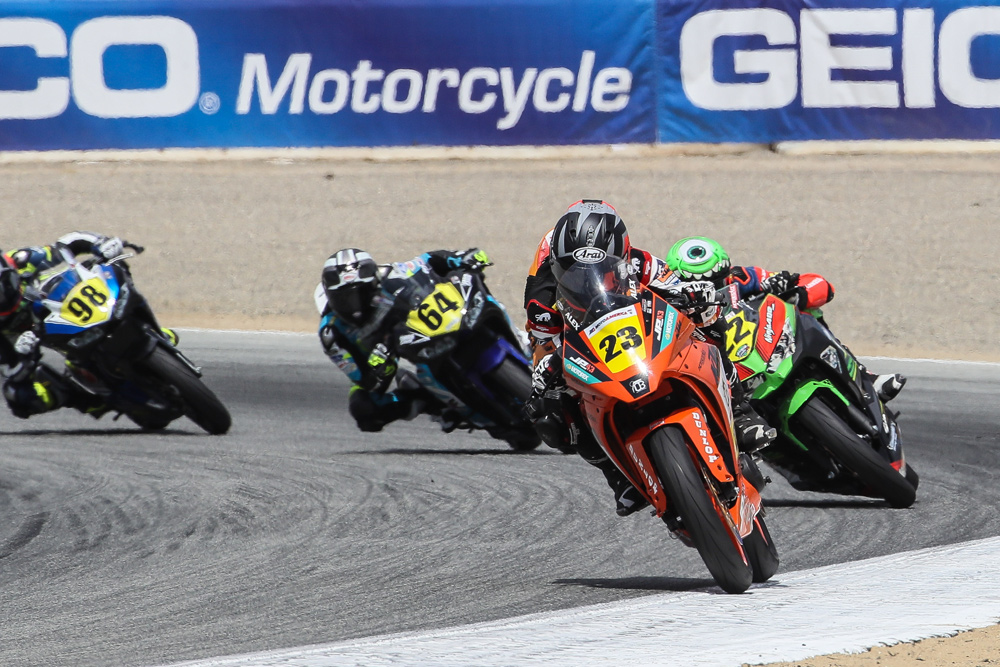 Alex Dumas has been one of the stars of the field, riding one of two KTM Orange Brigade RC 390 R machines.
Alex Dumas has been one of the stars of the field, riding one of two KTM Orange Brigade RC 390 R machines.
The class is a continual work in progress, and next year will once more see changes to try and make the racing faster, but keep the bikes close in overall performance.
“Our ultimate goal is to derestrict the bikes,” says Morse. “In Europe, they’re testing camshafts and throttle bodies, cutting the cylinder head, increasing compression, etc., but then, we’re also looking at different ways to restrict them, too. Things like using restrictor plates, throttle stops. Things that mean the manufacturers can have their rpm’s back so they have their gearing back, but reduce the horsepower. We are also looking at running slicks for next year with Dunlop.
“I believe if we get the balancing right, it’s still going to turn out to be the best rider. These are still 300s and 400s. They aren’t superbikes. They’re built on a chassis that is supposed to be an economical bike. So, if we get the balancing closer I think the racers will speak for themselves.”
|
Kawasaki Ninja 400 |
KTM RC390R |
Yamaha YZF-R3 |
| Road Atlanta |
Weight: 150 kgMax revs allowed: 12,000 rpm |
Weight: 136 kgMax revs allowed: 11,000 rpm |
Weight: 140 kgMax revs allowed: 12,000 rpm |
| Virginia International Raceway |
Weight: 150 kgMax revs allowed: 9850 rpm |
Weight: 136 kgMax revs allowed: 10,000 rpm |
Weight: 140 kgMax revs allowed: 13,000 rpm. Also allowed airbox modifications |
| Road America |
Weight: 145 kgMax revs allowed: 10,000 rpm |
No changes |
Weight: 138 kgNo changes to max revs |
| Laguna Seca |
No changes |
Weight: 142 kgNo changes to max revs |
Removal of restriction on igntion timing adjustment |
| Utah Motorsports Campus |
No changes |
No changes |
No changes |
| Sonoma Raceway |
No changes |
No changes |
No changes |
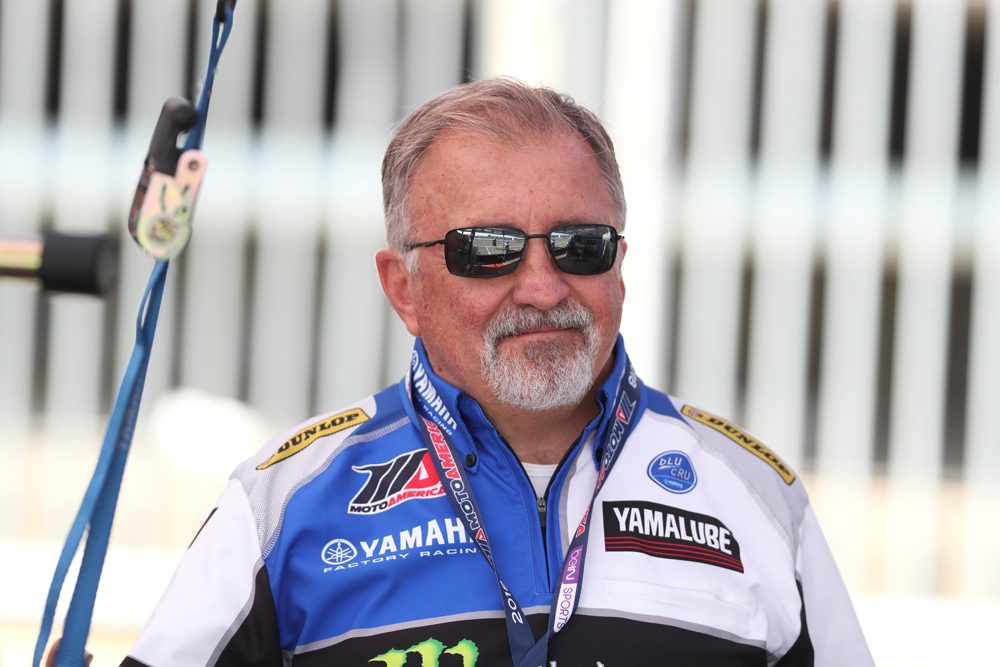
Keith McCarty—Racing Division Manager, Yamaha USA
Arguably the brand who has been most affected by the Junior Cup is the one that dominated in Europe last year: Yamaha.
The company’s Racing Division Manager, Keith McCarty, has been critical of the way the series has been implemented and we sat down with him at Sonoma to get his thoughts.
“I don’t think [the Junior Cup] met the expectations that we had for it, simply put,” McCarty begins. “Last year, the European rules appeared to be very neutral. Any brand could win. I think where things have gone awry is all companies want to win, no question. But I think that there’re a couple bikes that got brought into this category that really shouldn’t have because it disrupts the parity. At that point, nobody wins.
“I’ve said this very clearly that right now we have this big disparity between the bottom and the top. It started that way. We’re six races in, and that problem still exists. It might not be as large as it was at the beginning, but it still exists. So, in my mind, this is an entry-level class which means that it’s not up to the bottom portion to spend more money to raise itself to the top, because then it’s no longer an entry-level thing. It becomes a more expensive process. In my mind, the top should come down. Then you have a true beginner class. If people want to spend more money and go to those other bikes, that’s entirely up to them. But the level at which they’re able to race should be the same. That’s still not the case.
“I don’t think we [Yamaha] should be responsible to keep modifying what we have to catch up to everybody else. If that’s the case, then just change the rules to being open, and then we’ll decide if we want to be here or not. If they [MotoAmerica] just keep allowing bikes that don’t belong in there, then that’s where the issues come. KTM had a perfect bike legal for this class, as did Kawasaki (RC390 and Ninja 300). They both chose to make new ones to dominate the class. You couldn’t buy the KTM until the third race of our season. It’s pretty unfair to that 70 percent of the class, which happens to be Yamahas.”
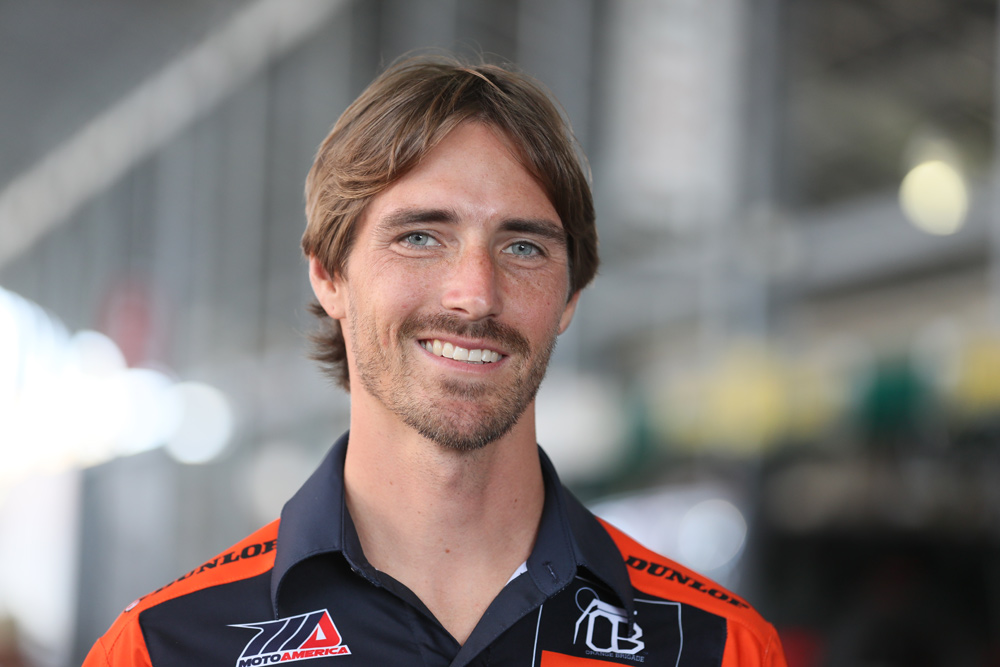
Chris Fillmore—KTM North America Racing Manager
Fillmore has been part of the now defunct RC Cup and was one of two riders, alongside former MotoGP rider Jeremy McWilliams, who helped develop the World Supersport 300 race kit and RC 390 R into the bike Alex Dumas and Sean Ungvarsky race in the KTM Orange Brigade outfit. This is what he had to say about the current rules structure for the race-kitted RC 390 R.
“For us, it’s difficult because when the rules were written, MotoAmerica switched from a spec series with the KTM RC Cup to an open manufacturers championship in the Junior Cup,” Fillmore said. “KTM strongly believes in the development of our products through racing, hence us creating the RC 390 R and Supersport 300 race kit. When we enter a racing series, we enter with 100 percent goals and effort to win, but the rules have changed on an ongoing basis and we have been restricted throughout the season. We now have different rules in MotoAmerica than what they run in the FIM World Supersport 300 class.
“What we, at KTM, created was a global program. Every weekend we share notes with the FIM teams and they share notes with us. But all that stops when the rules aren’t consistent for the season and they aren’t consistent from a global perspective. As an example, now MotoAmerica has restricted the KTM 450 rpm more than in the FIM World SSP 300 class. At only 10,000 max rpm, our power range window is very small, and in addition to that our peak power is down by over 10 percent. At 10,000 rpm, we’re 500 rpm under what a stock RC 390 comes with and the RC Cup bikes ran 10,500 rpm for the last three years.
“What makes it tough is that we want to push product and rider development. We want to have a global package. Ours is probably the only bike that is a standard in every series across the world because it’s a kit. We would like to see total parity between the FIM rules and MotoAmerica. We want our riders to have an opportunity develop and race both here in America and on a global level with FIM.”
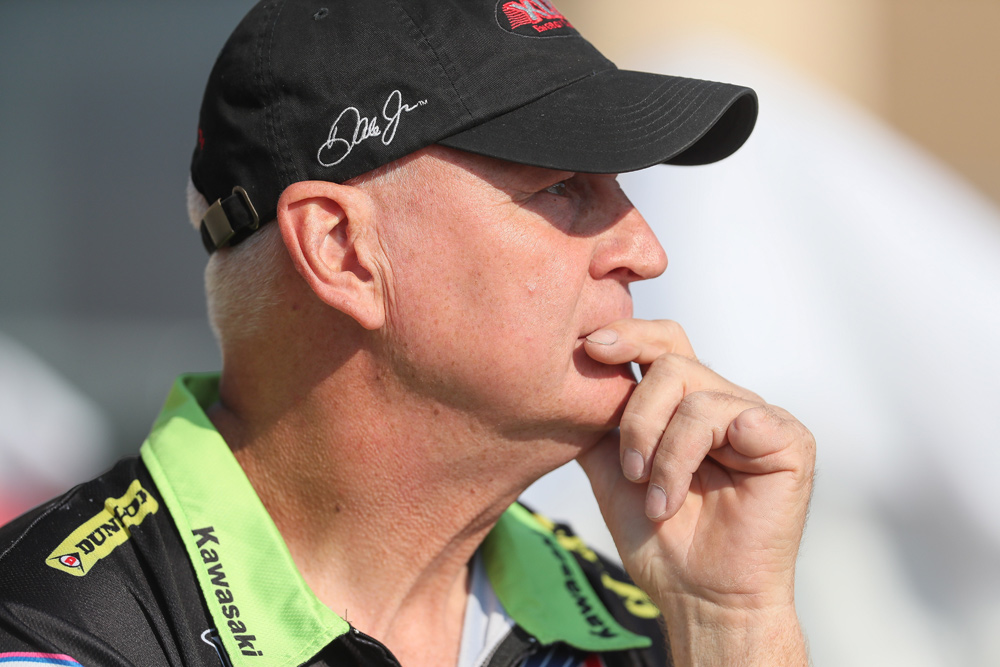
Dale Quarterly—Quarterly On Track Development Team Co-Owner
Racing veteran Dale Quarterly runs current Junior Cup front-runner Jamie Astudilo and lately, Utah winner Renzo Ferreira on Kawasaki Ninja 400s with team co-owner, Bob Robbins.
“First of all, there’s no way of fixing reality, and the reality is somebody is always going to make a motorcycle that’s faster than the other ones,” says Quarterly. “So now you’re trying to de-tune a faster motorcycle [Ninja 400 and KTM RC 390 R]. There’s kind of no reality to that, either. Depending on how you attempt to do it, you’re blocking that motorcycle from some sort of ability. Now it has no top-end, or you limit it with rpm and it can get there as fast as it wants, but you’re going to just be hitting the rev limiter and it won’t go anywhere. So that’s the first side.
“The second piece, I think, is my argument right from the get-go—Yamaha knew KTM and Kawasaki were coming out with bikes to run the series in 2018, which meant they were coming out with 2018 technology. So, the season starts, we annihilate the Yamahas, then suddenly they’re putting up a fuss. ‘No shit, Sherlock. Of course we’re going to annihilate you!’ They’re on 2015 motorcycle tech. We showed up with a 2018 motorcycle. Why are you backing us down to them?’
They had time to do their homework. They should have built something like we did. It’s stupid. The only reason they didn’t, and this is me talking, is there’re too many Yamahas here. There are two KTMs and three Kawasakis.
“At round one, we were overweight to start and over-horsepower to start. Then they [MotoAmerica] took the power away and left the weight. Then they realized the KTM was killing us still, but we were still killing the Yamaha. So, they took weight off us, gave us back 150 rpm, and then we’ve all been pretty competitive.
“Now the game is to find the gearing that fits to the racetrack, where before, you could just kind of gear it for the straightaway and live with it. You could be a little under rev, a little over rev. It didn’t care. But now it hits the rev limiter.”CN